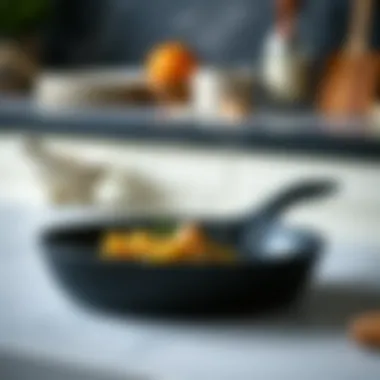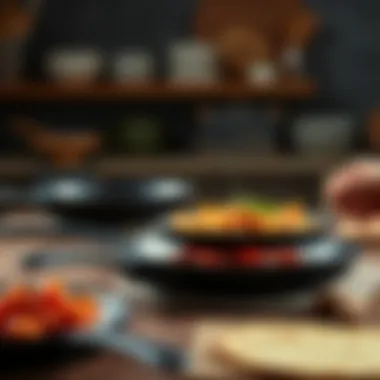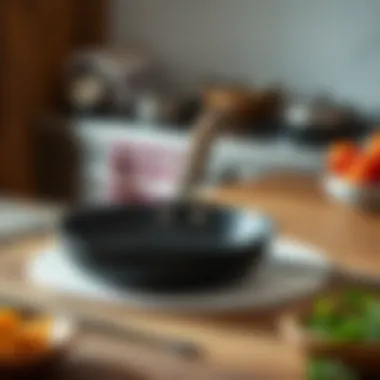Exploring Nonstick Skillets: Design and Use


Intro
In the hustle and bustle of modern life, the kitchen has evolved into a sanctuary for many. Amidst the pots and pans, nonstick skillets stand out as essential tools, often making daily cooking simpler and more efficient. These skillets offer a convenient solution for everything from an easy breakfast omelet to a perfectly seared piece of chicken. But what lies beyond their shiny surface? This article aims to peel back the layers and explore the intricate world of nonstick skillets, diving into their materials, design, and practical applications.
Moreover, we’ll discuss the benefits and the occasional pitfalls of using nonstick cookware. Many consumers find specific attributes quite appealing—ease of cleaning, reduced cooking time, and the ability to cook with minimal oil. However, it's not all sunshine and rainbows; the care and longevity of these skillets require relevant consideration. Throughout this piece, we'll provide compelling insights tailored for homeowners, designers, retailers, enthusiasts, and DIYers, ensuring that knowledge meets choices efficiently.
Whether you’re contemplating your next skillet purchase or simply looking to understand how these culinary tools integrate into your daily routine, this exploration seeks to enlighten. Let’s embark on the journey of understanding nonstick skillets — from their design trends to essential maintenance tips. By the end of this article, we hope you will be equipped to make informed decisions that align with both your culinary needs and aesthetic preferences.
Understanding Nonstick Cookware
Nonstick cookware has become a staple in kitchens across the globe, serving not just function but also ease to modern culinary practices. The significance of understanding nonstick skillets lies in their construction and the materials that make them effective. When you grasp how these pans work, you can make better choices that align with your cooking habits and health considerations. What can be more maddening than watching your perfectly cooked scrambled eggs adhere stubbornly to a pan? Such dilemmas can be remedied through knowledgeable decisions regarding nonstick cookware.
The ease of cooking with nonstick skillets is one of their most attractive features. Without a doubt, they allow users to cook with minimal oils and fats, promoting a healthier lifestyle. Being aware of the proper care and maintenance these skillets need will extend their life significantly, helping you avoid replacing them too often.
The Science Behind Nonstick Surfaces
Diving into the realm of nonstick surfaces is like peeking into the lab of an alchemist. What makes these surfaces so resistant to sticking, you might wonder? It predominantly comes down to a chemical called polytetrafluoroethylene (PTFE). This substance, more commonly recognized as Teflon, creates a slick surface that prevents food from bonding to the skillet. The effectiveness of PTFE in nonstick cookware hinges on how it interacts with heat. When exposed to high temperatures, the nonstick surface remains stable, facilitating easier food release.
Apart from PTFE, newer products are emerging that utilize ceramic and other innovative materials, promoting safety and sustainability in cooking. A growing number of manufacturers are moving toward inorganic coatings, which can offer similar nonstick properties without some of the safety concerns tied to traditional nonstick surfaces.
In exploring these materials, enthusiasts and cooks alike discover an intriguing intersection between science and culinary art, as understanding the functionality can greatly influence a consumer's purchasing decision.
Evolution of Nonstick Technology
The journey of nonstick technology is remarkable, layering decades of innovation on top of one another. Early advances in nonstick surfaces can be traced back to the mid-20th century when Teflon was first introduced in a frying pan. At first, users reveled in the ease of frying eggs and pancakes, quickly discovering its appeal — but as time passed, scrutiny began to arise due to health concerns over toxic fumes emitted at high temperatures.
Flash forward to the present day, and the evolution has been nothing short of phenomenal. Manufacturers have responded to criticism by developing safer alternatives that push the envelope further. For instance, brands have begun integrating ceramic coatings as they provide nonstick capabilities while sidestepping some of the issues related to conventional nonstick surfaces. This innovation not only meets consumer demand for safety but also incorporates eco-friendly initiatives.
The landscape of nonstick technology continues to shift, with research ongoing to find materials that are both nonsticky and environmentally conscious. As a result, consumers have more options than ever before, which allows them to select skillets tailored to their specific requirements and expectations.
"Understanding the evolution of nonstick technology informs smarter choices for your kitchen, blending safety with performance."
Given all this advancement, staying informed equips homeowners, designers, and culinary enthusiasts to pick the right options that suit not just their cooking style but also align with their values in sustainability.
Materials Used in Nonstick Skillets
Understanding the materials that constitute nonstick skillets is crucial for multiple reasons. Firstly, the choice of material affects the cooking experience itself. Different materials come with varying degrees of heat retention, durability, and safety, which can influence daily cooking practices in a household. Secondly, as consumers increasingly prioritize health and environmental considerations, the materials used are under scrutinized. It's vital to look beyond surface-level benefits and repaint a clearer picture of what exactly those materials offer in terms of functionality and sustainability.
PTFE and Its Implications
Polytetrafluoroethylene, commonly known as PTFE, has become one of the hallmark materials in nonstick cookware. Its nonstick properties are unrivaled, often leading to perfectly cooked foods that slide off the pan effortlessly. However, the implications of its use could be a double-edged sword.
While PTFE facilitates easier cooking and cleaning, there’s an ongoing debate surrounding its stability. When overheated, PTFE can release harmful fumes, known to affect birds and potentially cause flu-like symptoms in humans. To minimize these risks, many opt for PTFE-coated skillets made by reputable manufacturers who ensure their products meet safety standards. For many, the convenience outweighs the risks, given that basic cooking practices—like not leaving an empty skillet on high heat—can mitigate concerns significantly.
Ceramic Coatings: A Safer Alternative
Ceramic-coated skillets have emerged as a popular alternative to traditional PTFE options. Manufacturers tout them as safer due to their composition, which often includes sand-based materials rather than synthetic polymers. The idea is that they offer a nonstick surface that’s not only effective but also devoid of potentially harmful chemicals.
A significant advantage of ceramic coatings lies in their resistance to scratches and wear, granting them a longer lifespan under proper care. These skillets are also generally more tolerant to high heat than their PTFE counterparts. However, they do require careful handling as abrupt temperature changes can sometimes lead to cracking. While some consumers find ceramic skillets more aesthetically pleasing, it’s the perceived health benefit that often seals the deal.
Other Emerging Technologies
The market for nonstick skillets is rapidly evolving, and several emerging technologies are worth mentioning. Some examples include:
- Silicone Coated Skillets: These offer a unique combination of flexibility and nonstick performance without the drawbacks associated with PTFE, making them an interesting option for those looking to explore beyond conventional materials.
- Cast Iron with Enamel Coating: While not traditional nonstick, skillets with enamel coatings promise nonstick properties alongside durability and heat retention, appealing to those who value both performance and aesthetic appeal.
- Biodegradable Nonstick Solutions: Innovations in biodegradable coatings are in the pipeline. These aim to reduce environmental impacts without forfeiting cooking performance, providing a forward-thinking alternative for eco-conscious consumers.


In the world of cookware, materials matter. Each material comes with its own set of pros and cons. Understanding them is key to making informed decisions.
Advantages of Using Nonstick Skillets
Nonstick skillets have become a staple in most kitchens. Their popularity springs from a blend of practicality and culinary finesse. Understanding the advantages can help those in the market—whether homeowners, designers, or avid DIYers—make informed decisions. In this section, we’ll explore three key benefits: the ease of cooking and cleaning, health considerations, and their versatility across various culinary applications.
Ease of Cooking and Cleaning
One of the most significant perks of nonstick skillets is their user-friendly nature. Imagine flipping a pancake or sautéing vegetables without the worry of sticking. This attribute is not just about convenience; it fundamentally changes the cooking experience.
- Minimal Sticking: Foods slide off the surface easily, which reduces the chances of a ruined dish. This characteristic is especially valuable when preparing delicate items, such as eggs or fish.
- Quick Cleanup: After a delightful meal, the last thing anyone wants is to scrub stubborn residue off cookware. With nonstick skillets, a simple wipe with a soft sponge often suffices. This speeds up your kitchen routine, allowing more time to relish your creations with family or friends.
Cleaning becomes less of a chore when just a little soap and warm water do the trick. For those who are tight on time or dislike lengthy cleaning sessions, this feature is a true lifesaver.
Health Considerations
When it comes to health, nonstick skillets often have the upper hand due to their cooking requirements. The design allows for cooking with less oil or butter, which can significantly lower fat intake.
- Lower Fat Cooking: Many home cooks are conscious of their health. Using a nonstick skillet means you can achieve delicious, moist dishes while cutting back on excessive fats. This can be vital for those managing their weight or trying to eat healthier.
- Reduced Toxicity Concerns: Advances in nonstick technology have addressed many earlier concerns about chemical leachings, such as those linked to older PTFE (Teflon) formulations. Modern nonstick skillets utilize safer materials, adding a layer of reassurance in health-conscious cooking.
The shift towards more responsible nonstick options allows you to simmer, stir-fry, and more, with peace of mind.
Versatility in Culinary Applications
Nonstick skillets shine in versatility, widening culinary horizons. They are suitable for a broad range of cooking techniques.
- From Searing to Baking: One can easily sear meats or bake frittatas in these skillets without switching pans. This adaptability not only saves time but also enhances flavor profiles without needing additional cookware.
- Perfect for Beginners and Experts Alike: For novice cooks, the easy-to-use nature of nonstick skillets builds confidence in the kitchen. And for seasoned chefs, the ease of flipping and sautéing opens doors to experimentation.
Incorporating a nonstick skillet into your kitchen repertoire allows for seamless transitions between breakfast, lunch, and dinner dishes, effectively expanding the creative possibilities.
"A good nonstick skillet can transform your cooking game, making every meal an adventure to relish without the cleanup hassle."
As one strives to navigate the complex landscape of cookware options, recognizing these advantages offers clarity. Nonstick skillets have much to contribute, complementing various lifestyles and cuisines, making them a contender for anyone's kitchen.
Potential Concerns with Nonstick Cookware
When it comes to nonstick cookery, one might find it convenient but also fraught with concerns. This section aims to shed light on some significant issues surrounding nonstick cookware, unraveling common fears and offering a balanced perspective. First off, understanding these potential downsides is crucial not just for enthusiasts but for homeowners who utilize these items daily. The objective is to make sure that cooks of all levels know what they’re dealing with when they heat up their pans.
Chemical Safety: Addressing Common Myths
One of the most discussed topics related to nonstick cookware is the safety of its coatings. It's not uncommon to hear the urban legends about toxic chemicals leaching into food when cooking with nonstick skillets. Most articles bounce around snippets from studies or sensationalized headlines without darting beneath the surface. PFAS, known as per- and polyfluoroalkyl substances, are often thrown in the mix regarding health risks. While it’s vital to stay alert, recent research suggests that mainstream nonstick pans, those that don’t utilize harmful versions of PTFE, generally pose low risks when used correctly.
However, missteps like overheating your pan could lead to the release of fumes that might be harmful—particularly to birds. Ignoring a smoking pan while daydreaming about dinner can create an off-putting scenario. To mitigate concerns, always use nonstick pans according to manufacturer guidelines, avoiding high temperatures, usually above 500°F.
"While some worry about chemical exposure, proper usage and following guidelines are your best guards against potential risks."
Durability and Wear Over Time
Another concern looming over nonstick cookware is its durability. A key question that arises is: How long will my skillet last? Initially, nonstick skillets deliver an unmatched experience, allowing for smooth cooking and easy cleanup. But, they don’t boast the indestructible nature of stainless steel or cast iron. Marring on the surface from metal utensils or rough scrubbing can compromise the nonstick quality. However, by taking good care and being mindful during usage, one can stretch a nonstick skillet's lifespan somewhat.
Some factors that critically affect durability include:
- Type of Utensils Used: Non-metal utensils are always the best choice.
- Cleaning Methods: Avoiding abrasive cleaners can help maintain the surface integrity.
- Storage Practices: Stacking pans without protectors can scratch and wear down the surface.
When these elements align, a nonstick skillet can surprise you with its longevity. Just remember, it's never a one-way street; active maintenance is essential.


Selecting the Right Nonstick Skillet
Choosing the right nonstick skillet is paramount for an effortless cooking experience, and it can greatly enhance your time in the kitchen. An informed decision when selecting this essential piece can save both time and frustration, not to mention improve the flavors and textures of the dishes you're preparing. The right skillet should accommodate your particular needs, from the type of meals you cook frequently to your cooking style and even how much storage space you have in your kitchen.
Assessing Cookware Quality
When it comes to quality, not all nonstick skillets are created equal. A good skillet should not only have a reliable nonstick coat but also sturdy construction that can withstand high heat. Look for options made from durable materials, such as hard-anodized aluminum, which provides even heat distribution and reduces the chance of warping over time. Checking for warranty information can also give insight into the manufacturer's confidence in their cookware.
Several things to keep in mind while assesssing quality include:
- Thickness: A thicker base generally withstands heat better and distributes it evenly.
- Nonstick Coating: Research the coating material used; PTFE is commonly used but there are ceramic options available too.
- Handle Stability: Ensure the handle is securely attached and designed for easy grip, as this makes a world of difference during cooking.
Size, Shape, and Handle Options
When it comes to size, a skillet that fits your stove and your cooking needs is crucial. If you often prepare meals for a crowd, a larger diameter can be beneficial. However, for smaller households, a medium-sized skillet might suffice. The shape should accommodate the type of ingredients you typically use—round skillets are versatile, while square versions offer more cooking surface area.
Handle options are often overlooked but worth considering.
- Material: Silicone handles are heat-resistant and offer a comfortable grip.
- Shape: Contoured handles can be easier to manage, especially when you're multitasking.
- Hanging Options: Some skillets come with a hole in the handle for storage convenience.
Brand Comparisons for Informed Decisions
Navigating the vast array of brands can be a daunting task. Some brands are known for their focus on sustainability, while others prioritize advanced technology in their nonstick surfaces. It’s also key to consider customer reviews and satisfaction ratings, as these insights often highlight performance nuances that may escape initial scrutiny.
A couple of well-reviewed brands might include:
- T-fal: Known for their Thermo-Spot heat indicator, which ensures optimal preheating.
- GreenPan: Popular for their eco-friendly ceramic nonstick coating that is free from harmful chemicals.
By taking the time to compare reputable brands based on individual needs and requirements, home cooks can make educated choices that suit their culinary endeavors. This step ensures you end up with a skillet that not only performs well but stands the test of time in your kitchen.
Investing the time to select the right nonstick skillet pays dividends in both cooking and cleaning, leading to a more enjoyable time in the kitchen.
Care and Maintenance of Nonstick Skillets
Maintaining the integrity of nonstick skillets is not just a matter of prolonging their life; it also enhances your cooking experience. The effectiveness of these skillets hinges significantly on how well they're cared for. Proper maintenance helps maintain nonstick properties, ultimately ensuring that food cooks evenly and releases without hassle. It's also worth noting that a well-kept skillet can save you money in the long run—replacing cookware can pile up costs over time. So, let’s dive into best practices for keeping your skillets in top shape.
Cleaning Guidelines for Longevity
Cleaning is perhaps the most critical aspect of care. Here are some guidelines to consider:
- Use Gentle Cleaning Tools: Avoid abrasive sponges or steel wool. Instead, opt for soft sponges or cloths. This prevents scratching the nonstick surface.
- Opt for Mild Detergents: High-quality liquid dish soap usually works wonders. A gentle cleaner will cut through grease without damaging the coating.
- Let Skillets Cool First: Placing a hot skillet under cold water can cause warping. Allowing the skillet to cool down is crucial for its longevity.
- Soak with Care: If food is stuck, let the skillet soak in warm, soapy water for a bit before gently scrubbing. Doing this makes cleaning a breeze without compromising the nonstick surface.
- Avoid High Temperatures: Using metal utensils can cause scratches. Stick with silicone or wooden tools to protect the coating while cooking.
"Taking risks with cleaning methods can be like playing with fire; you may end up burning your skillet's lifespan."
Storage Practices to Prevent Damage
Where and how you store your nonstick skillet can affect its durability. Here are several tips to prevent any unintended damage:
- Stacking Wisely: If you stack your skillets, use a cloth or paper towel between them. This prevents scratching when they rub against each other.
- Hanging Skillets: If space allows, hang your skillets rather than stacking them. This can be a display while keeping them safe from scratches.
- Avoid Heavy Items: Don’t place heavy cookware atop nonstick skillets. The added pressure could warp the shape or damage the coating.
- Moisture Management: Always ensure the skillet is dry before storing it. Any moisture left on it can lead to residue buildup over time.
- TemperatureConsiderations: Store the skillet in a cool, dry place. High humidity conditions can impact the nonstick properties negatively.
Taking a few moments for proper care and storage can go a long way. It's a minor investment of time that pays off significantly with a skillet that performs well for years to come.
Alternative Cookware Options
When it comes to nonstick skillets, there’s a whole world of options out there beyond just the trusty teflon. Choosing the right cookware is a significant decision for both seasoned chefs and casual home cooks alike. Exploring alternative cookware options involves looking into various materials that can stand up to the test of time, offer health considerations, and suit specific cooking styles. Many homeowners and cooking enthusiasts find themselves at a crossroad when selecting between different types of cookware, each with unique characteristics and benefits.


Given the growing awareness of health and environmental impacts, many are re-evaluating their cookware choices. This section takes a look at some of the most popular alternatives to nonstick skillets, focusing on stainless steel, cast iron, and other eco-friendly options.
Stainless Steel: Pros and Cons
Stainless steel cookware is a staple in many kitchens, admired for its durability and resistance to rust and corrosion. The merits of stainless steel are plenty, but it also carries its share of drawbacks. Let's delve into both sides:
Pros:
- Durability: Stainless steel is known for longevity. You won't find yourself replacing it every few years.
- Non-Reactive: Unlike aluminum, stainless steel doesn’t react with acidic or alkaline foods. This means the flavors of your dishes will remain true, avoiding any potential metallic taste.
- Versatility: Suitable for all types of cooking, including induction, this metal can go from stovetop to oven seamlessly.
Cons:
- Sticking: The downside is that food can stick without proper preheating and using enough oil, which might discourage some from using it.
- Price Point: It can be on the higher end of the scale compared to nonstick options, depending on the brand and construction.
Cast Iron Versus Nonstick
The age-old debate between cast iron and nonstick skillets is fascinating. Cast iron cookware has been around for centuries and has its own die-hard fan base. Here's a look at how these materials stack up:
Cast Iron:
- Heat Retention: Cast iron excels at retaining heat, making it perfect for searing meats.
- Natural Nonstick Surface: When properly seasoned, it can offer a nearly nonstick cooking surface that improves with use.
- Health Benefits: Cooking with cast iron can actually add iron to your food, beneficial for those with deficiency concerns.
However, cast iron has its challenges:
- Weight: It can be cumbersome to handle, especially when full of food.
- Maintenance: Requires special care to prevent rust and ensure seasoning remains intact.
Comparatively, nonstick skillets shine when it comes to easy clean-up and require less oil for cooking, making them ideal for quick meals. Knowing what you plan to cook frequently can help inform your decision.
Other Eco-Friendly Cookware Choices
The trend toward sustainability influences cookware as well. Options like ceramic, glass, and even bamboo are gaining traction for their eco-friendly benefits. Here are a few noteworthy alternatives:
- Ceramic Cookware: Made without chemicals like PTFE or PFOA, ceramic alternatives offer a nonstick surface and typically come in vibrant colors. However, they may not be as durable and can chip with time.
- Glass Cookware: Excellent for baking and oven use, glass is entirely non-reactive. While not suitable for stovetop frying, it's useful for a range of dishes.
- Bamboo Utensils: While not a cookware material, bamboo tools can be a fantastic supplement that aids in keeping surfaces scratch-free, enhancing the life of your skillets.
"When making cookware choices, consider not just how it cooks, but how it fits into your lifestyle and values."
In summary, the alternatives to nonstick skillets exhibit a variety of traits valuable for different cooking contexts. It’s essential for each individual to weigh the pros and cons in relation to their own needs and culinary ambitions. As more cooks look for approaches that align with their health and environment commitments, exploring these options becomes more crucial than ever.
Future Trends in Nonstick Cookware
As the kitchen landscape evolves, so does the cookware we use. The future of nonstick skillets is not just about what’s on the surface; it’s about the innovation happening beneath it. Not only are we concerned about how well a skillet cooks, but also how it affects both our health and the environment. Recent trends suggest a shift towards smarter materials and greener processes—factors that will inevitably enhance our cooking experiences.
Innovation in Material Science
The realm of material science is witnessing some intriguing advancements that could redefine nonstick cookware. Innovative materials are emerging that not only promise better cooking performance but are also safer for our health. For example, a new class of coatings, such as sol-gel technology, utilizes silica in a way that’s more resilient than traditional nonstick surfaces. These new coatings are designed to withstand higher temperatures, offering both longevity and functionality.
Moreover, there's a growing interest in using natural materials to enhance nonstick properties. For instance, some manufacturers are exploring the incorporation of mineral-based compounds, like various ceramics, which could offer a non-toxic alternative to traditional polytetrafluoroethylene (PTFE) coatings. The emphasis here is clearly shifting away from synthetic materials, which is a win for health-conscious consumers.
One trend to keep an eye on is the development of textured surfaces that enhance food release without sacrificing the ability to sear. The innovative design can significantly change how heat distributes across the skillet's surface, potentially leading to improved cooking results.
"Advancements in material science are making nonstick skillets not just a convenience, but a tool for healthier cooking."
Sustainability Initiatives in Production
Sustainability is becoming crucial in cookware production, leading to innovative initiatives that aim to cater to eco-conscious consumers. Manufacturers are now focusing on how to lessen their environmental footprint through smarter production practices. This includes optimizing energy use during manufacturing and choosing sustainable materials. For instance, some brands are making strides in sourcing their raw materials responsibly, ensuring that they originate from sustainable sources.
Additionally, advancements in recycling technologies have opened the door for reusing old skillets, which historically wouldn't have been feasible due to the coatings involved. Companies are investing in processes that enable cookware to be recycled into new products, giving life to an otherwise discarded piece of equipment.
A significant aspect of this sustainability conversation centers on the packaging as well. More brands are opting for minimal and biodegradable packaging, aligning their branding with environmental values. This not only resonates with consumers but also sets a standard in the cookware market.
To summarize, as we look toward the future, the fusion of material innovation and sustainability initiatives sets the stage for smarter, safer, and more environmentally friendly nonstick skillets. Embracing these trends will not only benefit the consumer but will also foster an industry that is a little kinder to the Earth.















